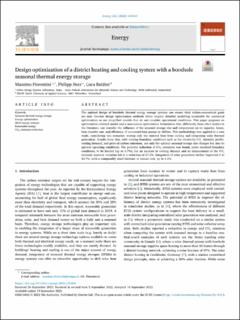Please use this identifier to cite or link to this item:
https://doi.org/10.21256/zhaw-25704| Publication type: | Article in scientific journal |
| Type of review: | Peer review (publication) |
| Title: | Design optimization of a district heating and cooling system with a borehole seasonal thermal energy storage |
| Authors: | Fiorentini, Massimo Heer, Philipp Baldini, Luca |
| et. al: | No |
| DOI: | 10.1016/j.energy.2022.125464 10.21256/zhaw-25704 |
| Published in: | Energy |
| Volume(Issue): | 262, Part B |
| Issue: | 125464 |
| Issue Date: | 2022 |
| Publisher / Ed. Institution: | Elsevier |
| ISSN: | 0360-5442 |
| Language: | English |
| Subjects: | Seasonal thermal energy storage; Energy optimization; Multi-energy system; Renewable energy; CO2 emissions reduction |
| Subject (DDC): | 620: Engineering |
| Abstract: | The optimal design of borehole thermal energy storage systems can ensure their techno-economical goals are met. Current design optimization methods either employ detailed modelling unsuitable for numerical optimization or use simplified models that do not consider operational conditions. This paper proposes an optimization-oriented model and a non-convex optimization formulation that, differently from other studies in the literature, can consider the influence of the seasonal storage size and temperature on its capacity, losses, heat transfer rate, and efficiency of connected heat pumps or chillers. This methodology was applied to a case study, considering two scenarios: storing only the rejected heat from cooling and integrating solar thermal generation. Results show that, with varying boundary conditions such as the electricity intensity profile, cooling demand, and price of carbon emissions, not only the optimal seasonal storage size changes but also its optimal operating conditions. The potential reduction of emissions was found, under standard boundary conditions, to be limited (up to 6.7%), but an increase in cooling demand and an enhancement of the intensity seasonal variation led to a reduction of 27.1%. Integration of solar generation further improved it to 43.7%, with a comparably small increase in annual cost, up to 6.1%. |
| URI: | https://digitalcollection.zhaw.ch/handle/11475/25704 |
| Fulltext version: | Published version |
| License (according to publishing contract): | CC BY 4.0: Attribution 4.0 International |
| Departement: | Architecture, Design and Civil Engineering |
| Organisational Unit: | Institute for Building Technologies and Processes (IBP) |
| Appears in collections: | Publikationen Architektur, Gestaltung und Bauingenieurwesen |
Files in This Item:
| File | Description | Size | Format | |
|---|---|---|---|---|
| 2022_Fiorentini-etal_Design-optimization-district-heating-cooling-system.pdf | 1.89 MB | Adobe PDF |  View/Open |
Show full item record
Fiorentini, M., Heer, P., & Baldini, L. (2022). Design optimization of a district heating and cooling system with a borehole seasonal thermal energy storage. Energy, 262, Part B(125464). https://doi.org/10.1016/j.energy.2022.125464
Fiorentini, M., Heer, P. and Baldini, L. (2022) ‘Design optimization of a district heating and cooling system with a borehole seasonal thermal energy storage’, Energy, 262, Part B(125464). Available at: https://doi.org/10.1016/j.energy.2022.125464.
M. Fiorentini, P. Heer, and L. Baldini, “Design optimization of a district heating and cooling system with a borehole seasonal thermal energy storage,” Energy, vol. 262, Part B, no. 125464, 2022, doi: 10.1016/j.energy.2022.125464.
FIORENTINI, Massimo, Philipp HEER und Luca BALDINI, 2022. Design optimization of a district heating and cooling system with a borehole seasonal thermal energy storage. Energy. 2022. Bd. 262, Part B, Nr. 125464. DOI 10.1016/j.energy.2022.125464
Fiorentini, Massimo, Philipp Heer, and Luca Baldini. 2022. “Design Optimization of a District Heating and Cooling System with a Borehole Seasonal Thermal Energy Storage.” Energy 262, Part B (125464). https://doi.org/10.1016/j.energy.2022.125464.
Fiorentini, Massimo, et al. “Design Optimization of a District Heating and Cooling System with a Borehole Seasonal Thermal Energy Storage.” Energy, vol. 262, Part B, no. 125464, 2022, https://doi.org/10.1016/j.energy.2022.125464.
Items in DSpace are protected by copyright, with all rights reserved, unless otherwise indicated.